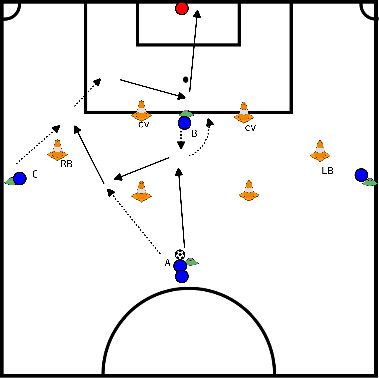Soccer drills
A 1 vs. 1 exercise in which the defending red team plays the ball in to the attacking blue team.
- When the attacking blue side has the ball, it looks for a 1 vs. 1 with the player from team red.
- If either team scores, both players switch sides so player red goes to blue and player blue goes to red.
- It may be that a red player takes the ball away. In that case, they may score on team blue's small goal.
- Team blue must score on a big goal that also has a goalkeeper.
- The players keep track of their own points and the three who finish last do 10 push ups.
Game rules:
- Ball out are 2 new players.
- If the goalkeeper catches the ball, it is play on so it is a 2 against 1 situation.
- Goal is also 2 new players.
Points of attention:
- Make sure the attackers dribble in at a high pace.
- Make sure the defenders defend forward.
- Make sure the defenders have a good stance.
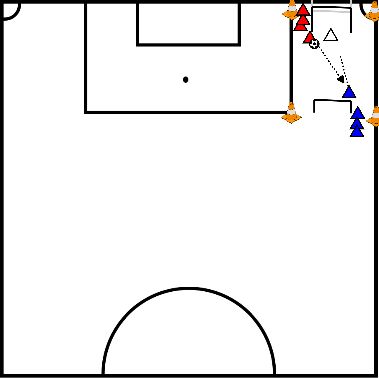
1st exercise:
- You start the first exercise by playing the ball in.
- The player accepts and passes it to the next player.
- The player also runs after the ball so that each time someone is in the right place.
- When you notice that it is too easy, you switch to the second exercise and it goes like this.
2nd exercise:
- Player 1 plays into player 2. He then drops the ball to player 1 who then passes it to player 3.
- Player 3 then drops it to player 2 and then player 2 plays diagonally to player 4 and so on.
Points of attention:
- Have the players coach each other.
- See if they are keeping track.
- If it is too easy, increase the pace.
- In exercise 2, then have the player really get under the ball when they get the ball back.
- The players must offer themselves.
- The players should ask for the ball.
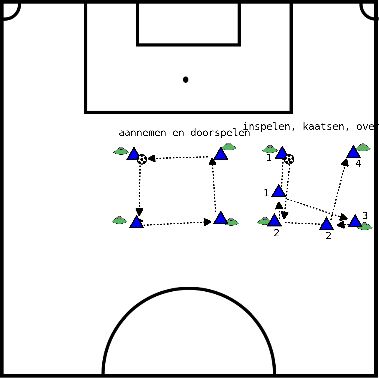
The purpose of this exercise is to play out of overtime.
- The 2 defenders of team red play the ball diagonally to a player of team blue.
- Then it is a matter of scoring and making sure they play out the overtal.
The teams just stay put and you have them switch sides after 6 minutes.
If the red team takes the ball away, they can score on a little goaltending by team blue.
Rules of play.
If the red team takes the ball away, they can score on a little goaltending by team blue.
Rules of play.
- Ball out is switch.
- Keeper the ball is play on.
- Scoring is switching.
Points of Attention
- Have the defenders defend on a line.
- Let the attackers make runs.
- Play the ball around at a high pace.
- If they can shoot, they should shoot.
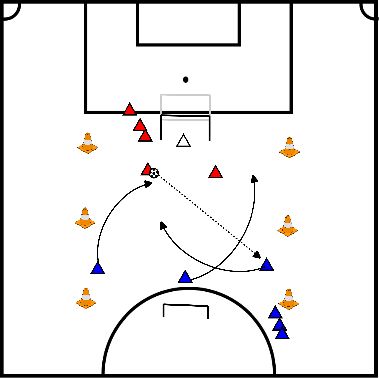
Lines run:
- Start on the back line.
- Sprint to hat 5 meter line.
- Back to back line, then to hat 16 meter line, back to back line again.
- Then to hat head circle and back to back line, then to center line and full sprint to back line.
- Take a breath and then do everything the other way around again.
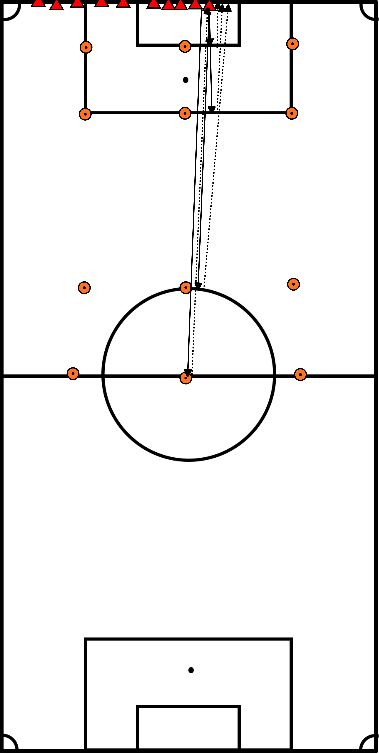
Set out a field for 4 v 4. For example 20 meters wide by 30 meters long.
Create a center line and a goal area with pawns.
A party game 4 v 4 / 5 v 5 or 6 v 6 is played.
You can deepen the game by giving different assignments such as:
1. Free play; no other assignments beyond the normal rules of the game.
2. No goal may be scored until everyone has crossed the center line.
3. A goal may only be scored inside the goal area after an end pass.
4. Hitting 3 times.
5. Crossing an x-number of times before scoring is allowed.
6. Combination of the above.
Create a center line and a goal area with pawns.
A party game 4 v 4 / 5 v 5 or 6 v 6 is played.
You can deepen the game by giving different assignments such as:
1. Free play; no other assignments beyond the normal rules of the game.
2. No goal may be scored until everyone has crossed the center line.
3. A goal may only be scored inside the goal area after an end pass.
4. Hitting 3 times.
5. Crossing an x-number of times before scoring is allowed.
6. Combination of the above.
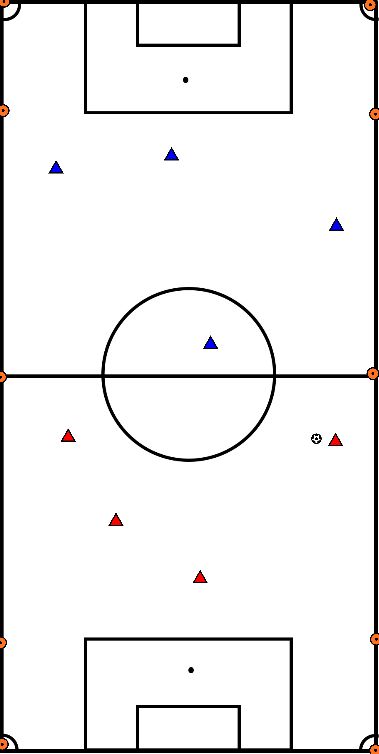
Distances: compartments 3 by 3 meters.
- Everyone stays in their box.
- Red is going to try to score by shooting the ball into one of the goals.
- The defender opposite the player with the ball steps toward him then to put pressure on the ball.
- The other defenders step in to shield the pass line.
Variants:
Harder: make boxes smaller than 3 x 3 meters.
Easier: make boxes larger than 3 x 3 meters.
Harder: make boxes smaller than 3 x 3 meters.
Easier: make boxes larger than 3 x 3 meters.
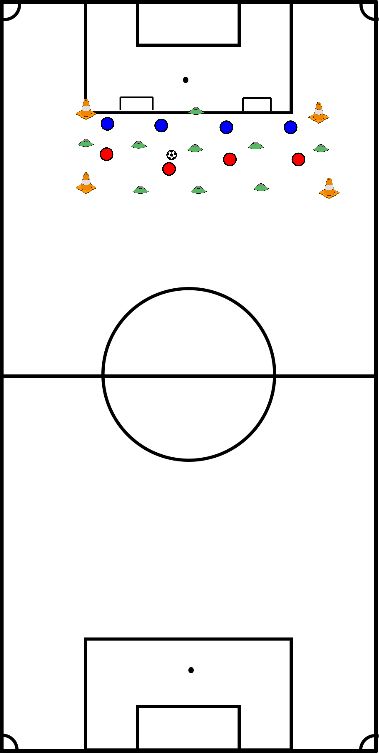
- This 1 vs. 1 exercise begins when the players have run around half the field.
- They must first go around the hat in the corner and then pass behind the goalie to start the 1 v 1.
- The attackers - red - pick up a ball when they have passed behind the goalkeeper and go on the attack.
Points of attention
- Pay attention to the attitude of the defenders.
- Make sure the attackers have pace.
- Don't make it too complicated. So one action on pace and score.
Rules
- Score over center line.
- If the player has been then switch sides.
- Pay attention to the attitude of the defenders.
- Make sure the attackers have pace.
- Don't make it too complicated. So one action on pace and score.
Rules
- Score over center line.
- If the player has been then switch sides.
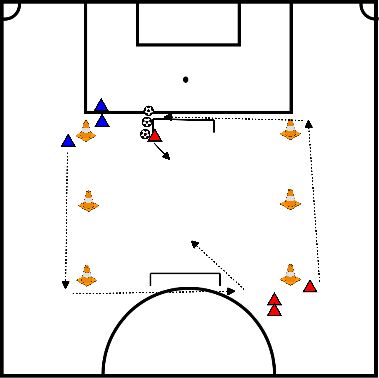
- Put two small goals on the edge of center circle facing each other.
- Make 2 teams with the same number of players.
- These line up next to the goals.
- The players choose a number from 1 to 5. With more than 10 players more numbers.
- The coach passes the ball to the center and calls out a number.
- From each team, the players with the called number play one against one on the goals.
- After a while they choose a new number.
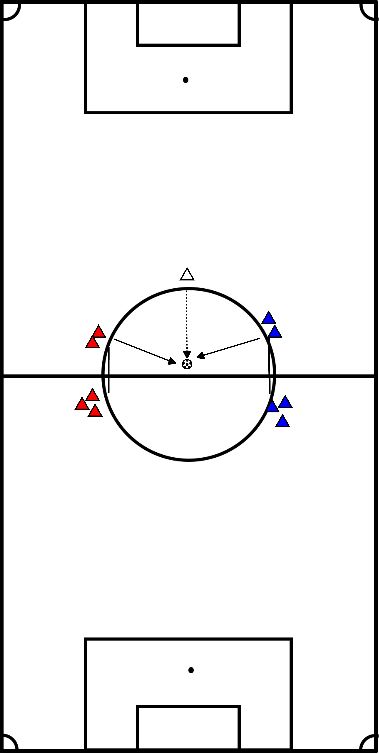
Distance: to the goal 16 meters
Size of squares: 3 by 3.
Assignment:
The defenders try to make it impossible for the attackers to score by shielding the pass lines.
Again, the defender, who has the attacker in front of him, presses with the ball and the rest squeezes in.
The attackers try to get the ball into the 16 to finish.
Rules of play:
Size of squares: 3 by 3.
Assignment:
The defenders try to make it impossible for the attackers to score by shielding the pass lines.
Again, the defender, who has the attacker in front of him, presses with the ball and the rest squeezes in.
The attackers try to get the ball into the 16 to finish.
Rules of play:
- The defenders are not allowed in the attackers' box!!!
- The attackers are allowed into the defenders' box to receive the stabbing ball.
- Once the ball is in the 16, the attackers may score. The defenders may also defend there!!!
- Goalkeeper is free in the 16 to intervene.
- Goal attempt over. Then the attackers become defenders and the defenders get the ball and then join behind as new attackers.
If the attackers cannot get into the 16, you can make it easier for them by making the boxes 1 meter wider.
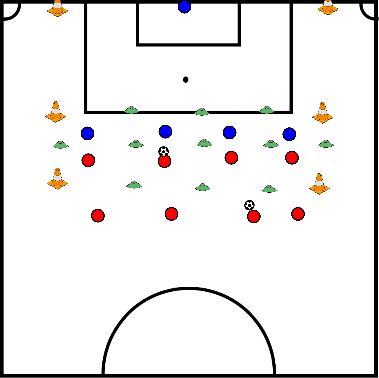
Distances: pawns 2 meters apart.
T= TRAINER.
CV= central defender.
Blue is defense.
Red is offense.
T= TRAINER.
CV= central defender.
Blue is defense.
Red is offense.
Explanation:
Box 1
- Trainer plays ball in to A, the closest man in this case, the CV, step forward to put pressure on player with ball.
- We see a gap created where there is space for the 2 attackers to run in. See the arrows from B&C.
Box 2
- Here we see the solution to cover this running line.
- The moment the defender steps in on the player with the ball, the other players step 1 meter to the middle to close the gap. In this way, no play can be made between them.
- The defender facing the attacker who gets the ball steps forward. The rest must slide inside.
Explanation to players:
- You explain that red are the attackers and blue are the defenders.
- You start in the starting lineup and play attacker A.
- You ask the players; what should the defense do now? Correct answer: opposing defender puts pressure on the man with the ball. Make sure the rest stay put.
- You ask the players; what is created now? Correct answer: space/ running line for the attackers to dive in. Demonstrate this by running one of the attackers into this gap.
- You now ask the players; how can they avoid this? Correct answer: all step in slightly. In this case exactly between the pawns.
Exercise:
- Ball at trainer is always back to beginning lineup.
- Initial exercise is passive, trainer plays to 1 attacker, the defenders take their steps, ball back to trainer.
- Then then play other attacker. Do about 5 minutes until defenders do their job.
- If it goes well quickly, you can make it harder just by increasing the ball pace.
- One step further is to allow the attackers to pass the ball among themselves and not just to the trainer.
- Then switch the attackers and defenders and do the same thing again. Both for about 10 minutes.
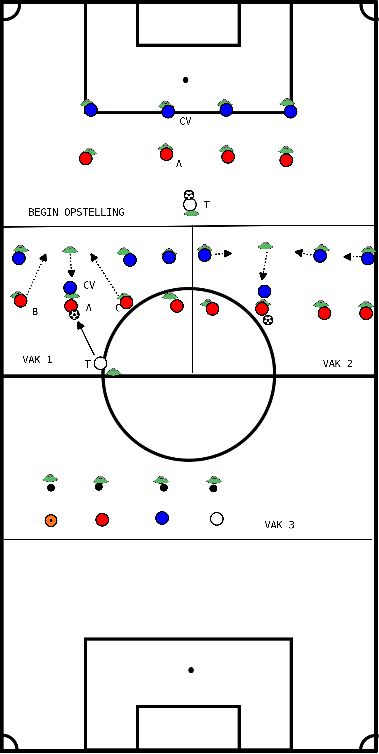
- There will be 4 rows of hats, each spaced 10 meters apart. As many lanes as you have pairs.
- Each lane has a 2-pair with 1 ball.
- Players line up at the first 2 rows of hats.
- The ball is at blue's sideline. This passes across the ground to red. This passes back across the ground and runs backwards to the next hats.
- Now blue passes with a firmer pass to red. This one passes back firmly and runs backwards to the last row of hats.
- Then blue passes to red with a high ball and runs himself to the row of hats closest to red.
- Now red stays on the back line and blue runs backwards to the next row of hats after each pass.
Pay attention to good kicking technique and good ball-taking.
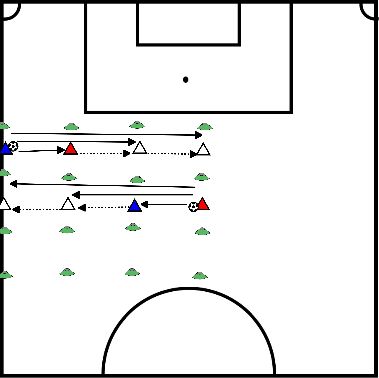
Distances:
- Pawns at 16 width 5 meters.
- Pawns underneath at 10 meters.
- Pawns side 3 meters from the 16 and 5 meters down.
- A stands 10 meters from the pawns.
- A plays the ball to the incoming B and immediately runs himself to the side past the defender.
- B drops the ball on A and goes to his starting position.
- As soon as B drops the ball, C starts running to pass the back.
- A plays the ball in the run along to C.
- C crosses past the last man and then puts the ball back to B.
- B rounds off.
- A becomes B, B becomes C and C retrieves the ball and connects behind and then through the other side
Coach moment:
A after pass immediately run through.
B get loose to ask for ball then immediately take position.
C at right time start not too deep because then too close to CV.
A after pass immediately run through.
B get loose to ask for ball then immediately take position.
C at right time start not too deep because then too close to CV.
